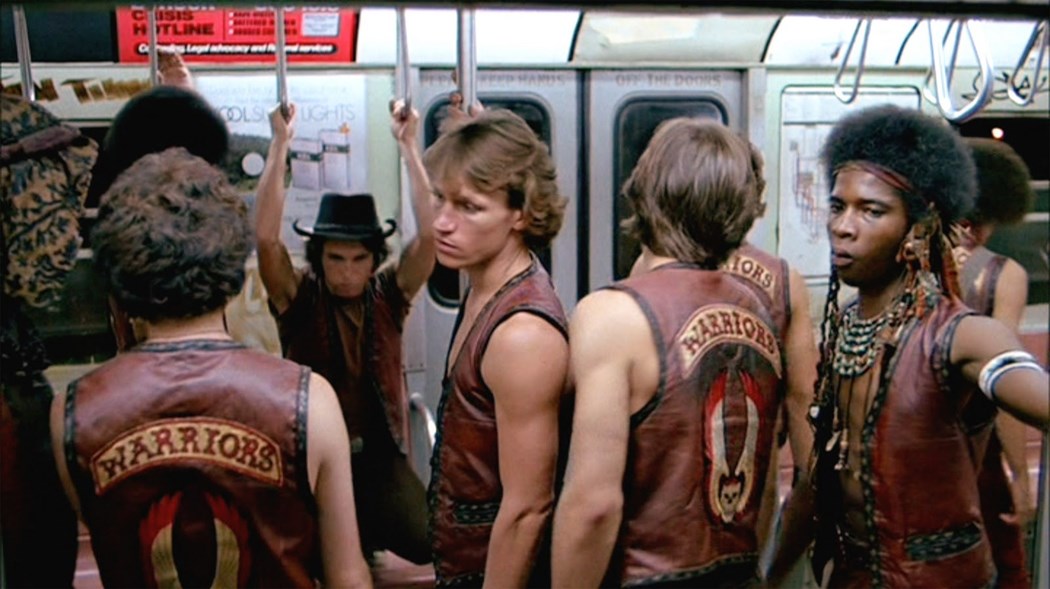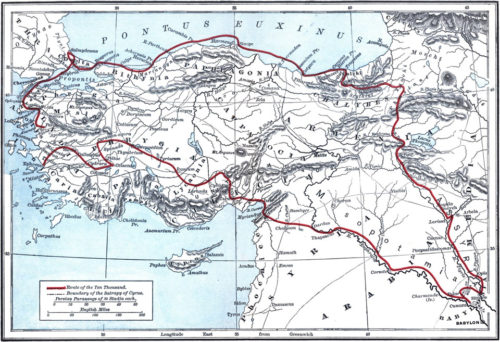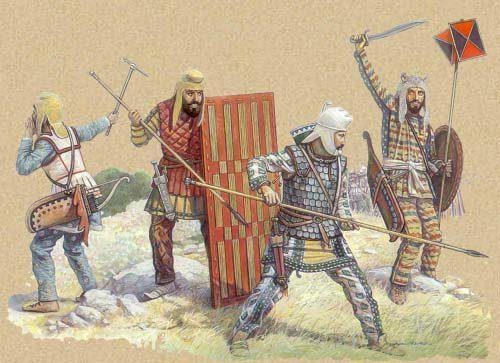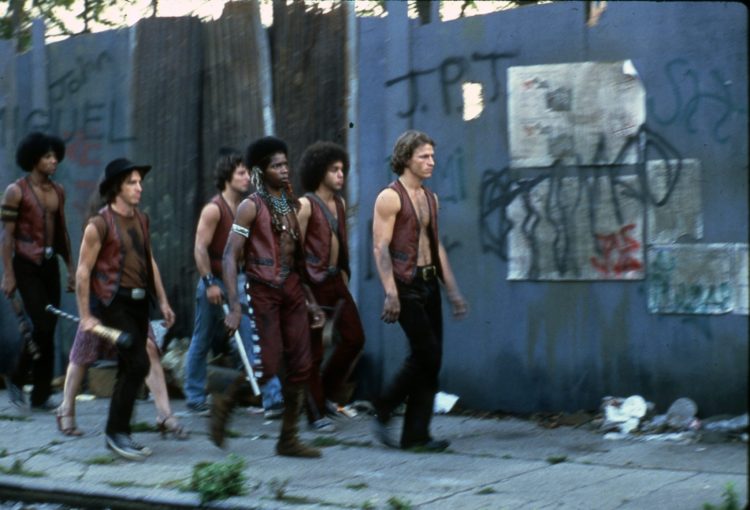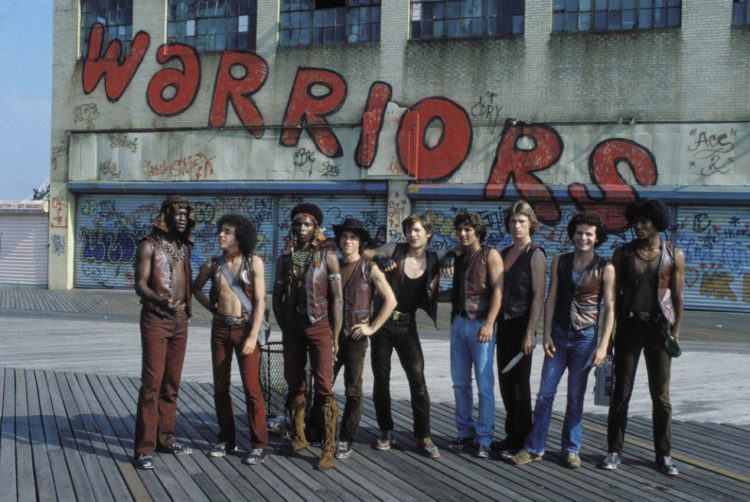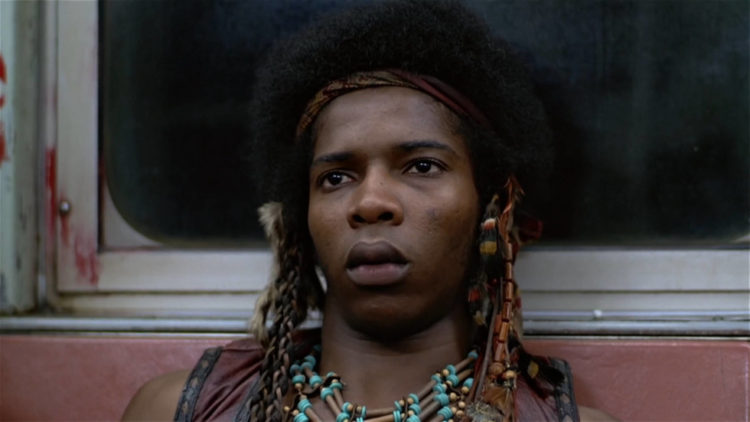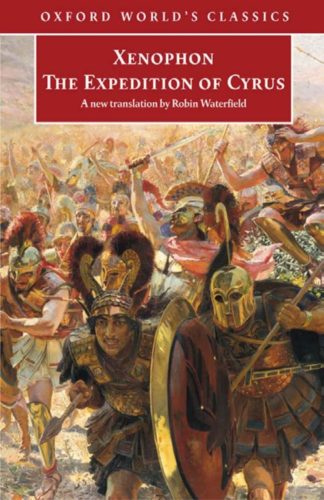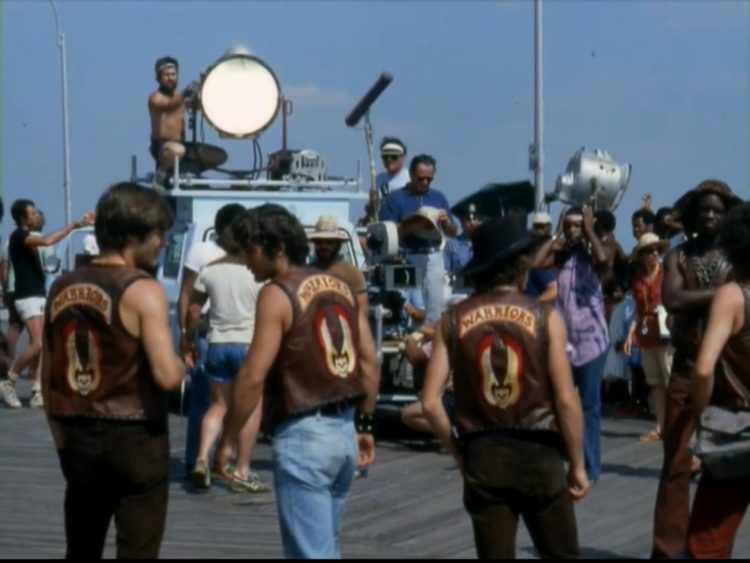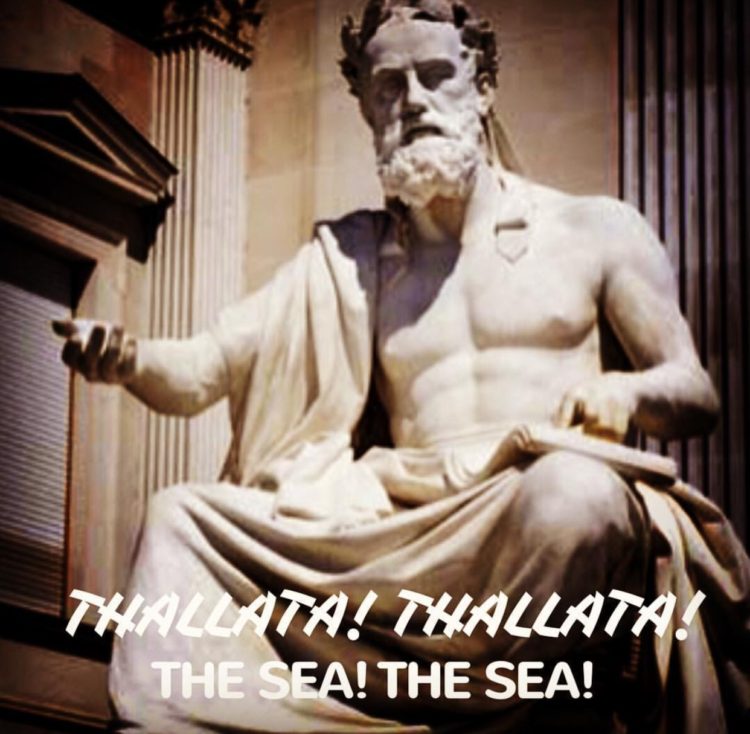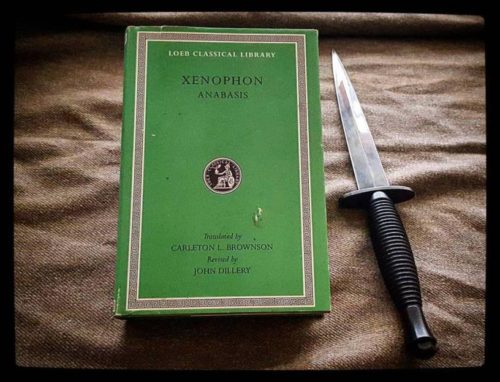
There’s a lot of searchable behind-the-scenes information online and we owe it to the Warriors Movie Site for providing a lot of that useful info. The movie came out nearly 40 years ago. Although the costumes and culture is dated the movie still grabs new fans.
I’m including the cult movie the Warriors because it’s a good movie and still holds up decades after it was first released. I hope that someone, unfamiliar with Xenophon and the movie, will read the book, see the movie or do both. If they gain an interest in Greek history we’ve done our job!
In the book, a young Athenian noble named Xenophon gives an eyewitness account of the attempt by the Ten Thousand, (a Greek mercenary army), to help Prince Cyrus overthrow his brother in order to steal the throne. The Ten Thousand (Ancient Greek: οἱ Μύριοι) were mercenary units, mainly Greek, employed by Cyrus the Younger to attempt to wrest the throne of the Persian Empire from his brother, Artaxerxes II. Their march to the Battle of Cunaxa and back to Greece (401–399 BC) was recorded by Xenophon (one of their leaders) in his work The Anabasis.But things do not go well.
Cyrus is killed and now the Greeks are without a patron or an employer. They are also without leadership for their Greek general and the rest of the higher leadership has been killed. The mercenaries have been betrayed. What are the options?
Xenophon encourages the ten thousand to flee through hundreds of miles of hard terrain. Every part of the story is interesting, such as when Xenophon must use diplomacy or warfare to obtain supplies for his men, even as their way is barred and their enemies are barreling down upon them. Xenophon uses strategy to traverse indirect routes, or travels directly through territories if he must. He has a serious plan, something all good leaders should have, and this will allow the men to survive. A good book on the matters of betrayal, success, leadership, controlling your forces, making ad hoc decisions, and doing nothing frivolous.
The film was based on a novel written by author Sol Yurick, which in turn was an adaptation from the Ancient Greek text Anabasis by Xenophon. The text told of Greek mercenaries stranded 1,000 miles behind Persian lines trying to fight their way back home. Here is some very interesting trivia about the movie:
The Warriors is a 1979 American cult action/thriller film directed by Walter Hill and based on Sol Yurick’s 1965 novel of the same name. Like the novel, the film borrows elements from the Anabasis by Xenophon.
It is a loose account of an army of Greek mercenaries who, after aligning themselves with Cyrus the Younger in the battle of Cunaxa (401 BC) in his attempt to seize the Persian throne, found themselves isolated behind Persian enemy lines.
Producer Lawrence Gordon had discovered the book which this film is based on, without a cover, at a book store. Sol Yurick wrote the original book as a rebuttal to the romanticized view of street gangs presented in West Side Story (1961) based on his experience as a New York City welfare department worker. After reading the description of the plot, he became very interested and bought the rights out of his own pocket.
Gordon hired David Shaber to write it and approached Walter Hill to direct it after working with him on Hard Times (1975) and The Driver (1978). Hill was very interested in the project but he felt that no studio would let them make the movie so the pair decided to make a western called “Last Gun” instead. However, financing fell though and Gordon was able to get The Warriors funded by Paramount Pictures. To this day, “Last Gun” has not been made.
The film rights to the novel were bought in 1969. The film originally sported the subtitle “Sometime in the Future”. This was removed for the original theatrical release version but was re-instated, displayed within the comic book title cards, for Walter Hill’s 2005 Director’s Cut DVD edition. Walter Hill was drawn to the “extreme narrative simplicity and stripped down quality of the script”. The script, as written, was a realistic take on street gangs but the director was a huge fan of comic books and wanted to divide the film into chapters and then have each chapter “come to life starting with a splash panel”.
The full name of “The Warriors” gang was actually “The Coney Island Warriors” but originally the movie was to be set in Los Angeles. The film added-on opening prologue for the DVD Director’s Cut edition of the movie and stated: “Battle of Cunaxa 401 BC. Over two millenniums ago, an army of Greek Soldiers found themselves isolated in the middle of The Persian Empire. One thousand miles from safety. One thousand miles from the sea. One thousand miles with enemies on all sides. Theirs was a story of a desperate forced march. Theirs was a story of courage. This too is a story of courage”. The travel route the Warriors gang must travel all through the night to get back home went from The Bronx via Brooklyn to Coney Island.
The movie was the first of four cinema film collaborations of actor James Remar and writer/director Walter Hill. The films include The Warriors (1979), 48 Hrs. (1982), Wild Bill (1995) and The Long Riders (1980). First of three collaborations of actor David Patrick Kelly and writer/director Walter Hill. The films include The Warriors (1979), 48 Hrs. (1982) and Last Man Standing (1996). First of three collaborations of director Walter Hill and cinematographer Andrew Laszlo. The films include The Warriors (1979), Southern Comfort (1981) and Streets of Fire (1984).
It was one of a number of 1979 “gang movies” which were first released in that year. The pictures included Walk Proud (1979), The Warriors (1979), Boulevard Nights (1979) and The Wanderers (1979). Then in 1980 came another New York gang movie, John Carpenter’s Escape from New York (1981). In order to get the movie out before rival “gang” film The Wanderers (1979), post-production on this picture utilized three editing teams in three editing suite cutting rooms which worked around the clock to finish the film. As such, The Warriors (1979) debuted in February 1979 with The Wanderers (1979) launching in July later that year.
In the original script for the movie, Cleon is killed by the Grammercy Riffs, Cochise is killed by the Baseball Furies, Ajax is caught by the police, Vermin is killed by the Lizzies, and Swan gets kidnapped by the Dingos. This leaves only four Warriors in the battle with the Punks. Swan does, however, reappear at Coney Island to fight the final battle after the Riffs learn the truth about who shot Cyrus.
In the original script, there was a gang called The Dingoes and in it were Kevin Bacon and John Snyder who plays the gas station man. They were supposed to be a homosexual gang with Doberman Pinchers and blonde wigs who captured Swan temporarily, but this was cut from the script. In the script, Fox was originally the love interest of Mercy, but the two actors had no chemistry and the Mercy romance was transferred to Swan.
Thomas G. Waites was fired eight weeks into principal photography, for being difficult and arguing with Walter Hill, so his character was removed from the movie when a cop threw him into the path of a train during a fight. To this day, Hill felt bad about the rough times he has with Waites. Waites is not in the final credits because he demanded that his name be removed.
1,000 extras were used at the big meeting, many coming from Riverside Drive Park. According to executive producer Frank Marshall, they originally hired a real gang member for the role as Cyrus, but could not find him on the day and never heard from him again. According to Michael Beck, however, Roger Hill was always supposed to play Cyrus, so the real story remains a mystery.
The original poster featured the words “These are the armies of the night. They are 100,000 strong. They outnumber the cops five to one. They could run New York City.” This upset and outraged many people; some tried to have the film banned.
According to the filmmakers on the Ultimate Edition DVD, the film was going to be a big hit after the movie was #1 at the box office charts despite negative reviews from critics (it earned $3.5 million in its opening weekend). However, word of mouth and a couple of incidents killed the film’s momentum. According to Walter Hill, what had happened was gangs were attracted to the film and they had saw their rival gangs and caused violent incidents.
Paramount Pictures panicked and decided to pull the movie out of theaters. Lawrence Gordon said the movie still kept going while the studio pulled the movie out of marketing. Despite this, the movie went on to be not only a cult hit but also a timeless classic; it even made a profit since it earned $22.4 million in initial box office receipts against a budget of only $6-7 million. After several violent incidents that occurred at various showings of the film, the producers decided to change the poster as a way of cutting down on the violence. The original poster featured the logo as well as a picture of several tough looking gang members. The second poster just featured the logo against a white background.
The Warriors’ vests were made of fake leather. According to an interview with a Hell’s Angel Member on the Howard Stern Show, the Warrior’s vest logo was taken from a picture of a bike built in a California prison by an incarcerated Hell’s Angel, which appeared in a motorcycle magazine. It has apparently caused several fights; Hell’s Angels will violently defend ownership of any of their logos.
Actual gang members wanted to challenge some of the cast members but were dealt with by production security. Crew members were sent death threats because local gangs weren’t cast. Thousands of dollars worth of equipment were damaged when one gang tore through the set during a lunch break. Despite being a movie about tons of gangs, the only gangs that are ever actually seen using guns are the Lizzies and the Rogues.
Robert De Niro was asked to be Cowboy, but he passed on it. Tony Danza was offered the lead, but he chose to film the television series Taxi (1978) instead. James Remar earned his role as Ajax after becoming so involved in the audition reading of the park bench scene, that he lifted the massive table around which the director and producers were seated. Irwin Keyes was also considered for the role of Ajax, but wasn’t cast because Walter Hill thought he was too old for the part. However, Keyes still appears in the movie as the cop who arrests Ajax in the park.
Newcomers were cast to create the feel of “real people caught in dangerous situations”. The cast felt like they were a gang before filming started. James Remar even spent time in Coney Island so he could observe real individuals to base his portrayal of Ajax on. Ajax’s line, “I’ll shove that bat up your ass and turn you into a Popsicle” is ranked #12 on UGO’s Top 50 Tough Guy Lines, and on the top 50 Greatest Baseball Lines Ever. The character Ajax was named after the Greek Warrior. When Ajax and Cowboy are running from the Baseball Furies, you can see several times that James Remar reaches over and slaps Tom McKitterick on the butt. He does this to coax him into running faster. When the fictitious Turnbull ACs visited a hamburger joint during filming, people fled in fear of being attacked.
David Patrick Kelly also played a character named “Luther” in another Walter Hill movie 48 Hrs. (1982) made and released around three years later. He improvised Luther’s “come out to play-ay” taunt, basing it on an intimidating neighbor of his.
Filming during the scene with the Orphans was interrupted by a police chase. Filming was allowed to take place uninterrupted all night, a first. Filming sometimes had to move due to noise from crowds that came to watch. Some crow members were forcibly removed from set. Director of Photography Andrew Laszlo campaigned successfully to have a scene early in the film where there is a sudden rainstorm, because this allowed him to “wet down” the streets for the rest of the movie and produce lighting effects that wouldn’t have been possible on dry surfaces (it also worked well with the film’s limited budget). Due to lack of Lights, extra light posts were added to the park scenes. During the opening credits of the T.V. version, the knife that is thrown into the board was thrown (off camera) by Penn Jillette. Entertainment Weekly ranked this Number Six on their “Guilty Pleasures: Testosterone Edition” list in their March 30, 2007 issue.
In the subway where Mercy is running with Fox’s double, she fell and broke her wrist because the actor didn’t let go of her hand. This is why she later appears in a jacket as it is covering up the cast. The filmmakers had Mercy disappear from the film for a while, meeting up with the Warriors at the subway platform and saying that she stole the jacket she was wearing before arriving there. The gang member named Snowball did not say a single word until the end when he gave a small statement about how they should fight the Rogues to avenge their fallen friends.
Michael Beck was discovered by Walter Hill when Hill was watching the movie Madman (1978), which Beck co-starred in with a then less-famous Sigourney Weaver. Hill saw that film because he wanted to see Weaver’s performance, as she was being considered for the upcoming film Alien (1979), but was so impressed by Beck’s work that he had him come in for an audition which led to his being cast in THE WARRIORS.
Michael Beck accidentally broke three of a stuntman’s ribs while filming the scuffle with the Furies. Beck himself was unaware of this until he was confronted by the same stuntman at a ‘Warriors’ reunion event 37 years later. In one take, Michael Beck (Swan) swings a bat into Deborah’s face (in the scene where he throws it at the cop). She was rushed to hospital at 3am for stitches and still has a scar. He was scripted to escape and lead The Warriors home.
The Baseball Furies are a reference to Second Base, an uptown gang from the 1970s. Second Base wore Lettermen jackets with “Second Base” across the backs, not the baseball uniforms and painted faces of the Baseball Furies. The connection is quite obvious when New York Boppers are informed that The Warriors are “on Second Base”. The fight between the Warriors and the Baseball Furies was scripted as extremely graphic and realistic. Producer Lawrence Gordon suggested adding music to defuse the impact of the violence. One of the “Baseball Furies” was late martial-artist/actor Steve James. One of the “Punks” in the men’s room-brawl is Craig R. Baxley. He is the one that gets thrown into a toilet booth upside down. Another is the late stunt-great A.J. Bakunas. The Baseball Furies were created due to Walter Hill’s love of baseball and the Glam Rock band Kiss. The Baseball Furies were all around 30 or older and from Stunts Unlimited
Paul Greco’s character, the Orphan leader, isn’t given a name in the film, and other media frequently refer to the character simply as “Orphan” or “Orphan Leader.” However, his character’s actual name, Sully, was revealed in the Warriors video game.
President Ronald Reagan was a fan of the film, even calling the film’s lead actor, Michael Beck, to tell him he had screened it at Camp David and enjoyed it. Ranked #16 in Entertainment Weekly’s “Top 50 Cult Films of All-Time.” Real street gangs appear in the film.
Michael Beck stated to NME
“This was the first year I was married and my wife and I lived in a studio apartment in New York. We had a dog which needed walking several times a day. I was taking him for his final walk around the block at about nine in the evening, and I got home, and my wife said, ‘You’re not gonna believe who just called… The White House’. I think I went off with some swear word, and she said ‘they’re gonna call back in about ten minutes, you wait buddy’. Sure enough the phone rang, and it wasn’t actually President Reagan, it was his press secretary, who said “president Reagan wants you to know how much he enjoyed this past weekend’s screening of The Warriors at Camp David’. Pretty crazy, huh?””
Stunt coordinator Craig R. Baxley put the cast through stunt school because Walter Hill wanted realistic fights depicted in the film. The actors playing The Warriors bonded early in the shoot, on and off the set.
Subway equipment throughout the entire movie consisted of IND/BMT R-27 and R-30 units, even though the IRT is implied in many instances. Apparently, no attention was paid to train markings, which varied considerably and were often unrelated to the actual routes traveled on. Other subway cars seen briefly are R-12, R-42 and R-46 units. Surprisingly this adult R rated, gritty, and violent gang themed film (along with The Wanderers (1979)) has a connection to the PBS children’s program 3-2-1 Contact (1980). Ginny Ortiz (who played The Candy Store Girl) and Leon W. Grant (who Played Boo Boo over at The Wanderers (1979)) both had minor roles in both movies would go on to be the original hosts of 3-2-1 Contact (1980). Plus, the late Marcelino Sánchez who was featured both in the “Bloodhound Gang” segments on 3-2-1 Contact (1980) and as “Rembrandt” one of The Warriors.
https://www.youtube.com/watch?v=F9ZhrD6hMcc
The entire film was shot on the streets in New York City with some interior scenes done at Astoria Studios. They would shoot from sundown to sunrise. The film quickly fell behind schedule and went over budget. While they shot in the Bronx, bricks were tossed at the crew. Actor Joel Weiss remembers that filming of his scene at Avenue A was cancelled because there was a double homicide nearby. For the big meeting at the beginning of the film, Walter Hill wanted real gang members in the scene with off duty police officers also in the crowd so that there would be no trouble. The choreographed fight with the Punks in the men’s room took 5 days (8pm to 7am) to shoot. The crew once got urinated upon from a tower block due to the noise they were creating in the night. The film apparently took 60 days to shoot from midnight to 8am. The film trucks were “protected” by a real gang called The Mongrels for $500 a day.
The Homicides were a real Coney Island gang, and they didn’t approve of fictional gangs wearing colors on their turf. The wardrobe department made sure nobody walked off location wearing The Warriors colors. The actors were safe during the cemetery scene in Brooklyn because of a fence surrounding it.
The night scenes of The Warriors talking about Cyrus and the big meeting at The Bronx were part of re-shoots after the original opening of the film was cut out. The original opening of the film (which can be viewed on the Ulimate Edition DVD) was set in Coney Island during the daytime which Cleon’s girlfriend says goodbye to Cleon and also features the rest of the gang being told by Cleon why they were chosen to go to the big meeting. The main reason why this opening was cut was because the editors told Walter Hill that the scene completely fell through because it set in the daytime (95% of the film is set in nighttime) and they felt it wouldn’t work since it would cut to nighttime and it was a distraction. Walter agreed and decided to go back and re-shot the conversations that The Warriors have before their train arrives.
The Warriors aimed to create “tribal feeling of going into battle together, of loyalty, of support and shared goals” and to have “the audiences’ sympathy as they fight off all the other gangs in the city”. There were always crowds of spectators during filming, even at 3am in the freezing cold.
This is a “collective hero” movie, in which the protagonist actually consists of nine people acting (more or less) as one. Walter Hill uses this gimmick frequently; other movies he has made that work this way are Southern Comfort (1981) and The Long Riders (1980). The movie uses a plot device common to some of the movies written and/or directed by Walter Hill where the leader of a group is eliminated in the first act, whereby the leadership and security of the team is thrown into disarray by the loss of its head. Such Hill pictures using this story element include Aliens (1986), The Warriors (1979) and Southern Comfort (1981). The Warriors sign painted on the bath house for one of the photos was painted over a real gang’s tag. The gang didn’t take too lightly to this, so the producers paid them to be in the film. There is a rumor that one of the gang members is played by a young Samuel L. Jackson
Vermin was scripted to be killed by the Lizzies but Terry Michos who played Vermin made his character more comical to make it more memorable and get more on-screen appearances in the movie, which worked and the death scene was taken out.
https://youtu.be/nOUvwvtOOsQ
Walter Hill and Larry Gordon saw David Patrick Kelly in a Broadway play called “Working”. Kelly performed a monologue as a hippie that espoused peace and love, but was actually extremely passive-aggressive. Walter Hill says of this film on his 2005 DVD introduction: “At the very beginning, I said [that] to do this properly and to do the vision of the novel, it really only makes sense if you do it all black and Hispanic. And the studio was not very keen on that idea. I later came to realize that the studio forced me into the comic book idea, because it was the only way I could make it all make sense to myself”.
Hill originally wanted a tough Puerto Rican girl to play Mercy. He also wanted an initial subtitle which read “Sometime in the future” but Paramount thought it sounded too much like Star Wars: Episode IV – A New Hope (1977).
At some point during the film’s promotion or after the initial ruckus when released, it was ordered that several bits of voice over in the trailer be censored. This is done by placing a piece of tape over the optical soundtrack. In the trailer, the narrator states “…between them and safety stand 20,000 cops and 100,000 sworn enemies.” The fact that gangs out numbered the police by five times apparently was considered a security issue and the words “ten thousand” and “twenty thousand” were bleeped out with tape. (This probably coincides with Paramount promoting the film after violence at screenings, such as the new poster campaign).
Contrary to popular belief one of the young “Prom Couples” females is NOT played by a young Debra Winger. In fact the two female prom cast members are Gwynn Press and Jodi Price. Deborah Van Valkenburgh’s boyfriend at the time discouraged her from auditioning because he thought the director was looking for someone more well endowed. Debut American film of American actress Mercedes Ruehl who plays a policewoman. The movie was though actually the second feature film for Ruehl whose one previous picture had been the Brazilian movie Dona Flor and Her Two Husbands (1976). Debut performance in a film production of actress Deborah Van Valkenburgh.
The park at the beginning of the movie was supposed to be in the North Bronx. The scene was actually shot in Riverside Park, on Manhattan’s Upper West Side. The picture is listed as a “Cult Film” by Danny Peary in his “Cult Movies” book, his first about them. The picture’s opening credits title cards and the film’s movie poster title logo featured font lettering in the form of graffiti paint.
The revolver that the Rogues gang leader, Luther uses to assassinate Cyrus is a Smith & Wesson model 28 .357 magnum. The Rogues’ car in the Coney Island confrontation was a 1955 Cadillac hearse. The scene in the men’s room with the Punks was the only scene shot on a set. The set, the only one constructed for the movie, was located at Astoria Studios, Long Island City – Queens. The second-in-command of the Riffs who takes over when Cyrus is killed is named Masai. This name is not used in the film, however it does appear in the credits. The studio would not allow Craig R. Baxley to bring any stunt men from Hollywood and he needed someone to double for the character of Cyrus so he did the stunt himself dressed as the character. The subway footage during the opening titles was filmed along the express tracks of the IND Fulton St. line in Brooklyn. The television version started with a day shoot at Coney Island with Cleon and his girlfriend (played by Pamela Poitier). The producers cut this scene stating that the only day scene should be at the end of the film after a night of horror.
Here are the gangs that were listed in the script (some made it into the movie; others didn’t): – The Alleycats, – The Amsterdam All-Stars, – The Baseball Furies aka The Furies, – The Black Hands, – The Blackjacks, – The Big Trains, – The Boppers, – The Boyle Avenue Runners, – The Charlemagnes, – The Colt 45’s, – The Dealers, – The Delaney Rovers, – The Destroyers, – The Dingos, – The E Street Blazers / The E Street Shufflers , – The Easy Aces, – The Electric Eliminators, – The Eighth Street Bombers / The Eighth Avenue Apaches, – The Fastballs, – The Fifth Street Bombers, – The Filmores, – The Firetasters, – The Five Points, – The Gerrards, – The Gladiators, – The Go Hards, – The Gun Hill Dancers, – The Gramercy Riffs aka The Riffs, – The High Hats, – The High Rollers, – The Homeboys, – The Hoplites, – The Howitzers, – The Huks, – The Hurricanes, – The Imps, – The Jesters, – The Jones Street Boys, – The Judas Bunch, – The Jupiters, – The Knockdowns, – The Knuckles, – The Lizzies, – The Locos, – The Magicians, – The Meatpackers, – The Mongols, – The Moonrunners, – The Napoleons, – The Nickel Steaks, – The Nightriders, – The Ninth Avenue Razors, – The Orphans, – The Panzers, – The Phillies, – The Plainsmen, – The Punks, – The Queen’s Bridge Mutilators, – The Real Boys, – The Red Hook Shooters, – The Roadmasters, – The Rogues, – The Romans, – The Runaways, – The Saracens, – The Saratogas, – The Savage Huns, – The Shanghai Sultans, – The Southern Cross, – The Speedwagons, – The Sports, – The Stevedores, – The Stilletos, – The Stonebreakers, – The Terriers, – The Turks, – The Turnbull AC’s, – The Van Cortlandt Rangers, – The Warriors (aka The Coney Island Warriors), – The Whispers, – The Xenophones, – The Xylophones, – The Yo-Yo’s, – The Youngbloods, – The Zodiacs, – The Zulus.
An opening narration was planned, voiced by Orson Welles. It’s included on the director’s cut DVD, along with comic book-style transitions between scenes. According to the film’s composer Barry De Vorzon, the picture was the first movie, bar the film’s closing song, to feature an entire music score of synthesized rock ‘n’ roll music. Def Squad sampled the line “Can you dig it?” for their 1998 song “Can U Dig It?” One of the songs featured on the soundtrack, “In Havana” by Kenny Vance and Ismael Miranda, features backup vocals by numerous singers, including Chevy Chase. The group Pop Will Eat Itself used sound bites from the movie for their song Can you Dig it? On their 1989 album This is the day…..This is the hour…..This is this. The original preview uses the music from Sorcerer (1977) by ‘Tangerine Dream’.
Here’s the ending scene where our heroes, not unlike the 10,000, find the sea. The Russo brothers, who had much success with Captain America and the Civil War movies, are developing a tv series due to come out in 2018.
*The views and opinions expressed on this website are solely those of the original authors and contributors. These views and opinions do not necessarily represent those of Spotter Up Magazine, the administrative staff, and/or any/all contributors to this site.
Thálatta! Thálatta! (Greek: Θάλαττα! θάλαττα! — “The Sea! The Sea!”) was the shouting of joy when the roaming 10,000 Greeks saw Euxeinos Pontos (the Black Sea) from Mount Theches (Θήχης) in Trebizond, after participating in Cyrus the Younger’s failed march against the Persian Empire in the year 401 BC. The mountain was only a five-day march away from the friendly coastal city Trapezus. The story is told by Xenophon in his Anabasis.

